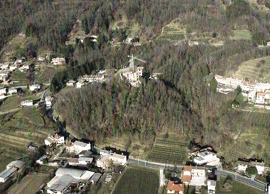The Hill
Situated between the Rio Rosso(1), which at North runs from East to West and now erroneously called ‘Rio Bosso’, and Rio Prampero running North-East to South-West, the hill is naturally outfit to build a castle, for whatsoever purpose – defense, development, protection, health, etc.
 The anthropization took place in the roman age when it was bound by the road path connecting Julium Carnicum (Zuglio) with Forum Julii (Cividale), a pathway that exists to these days. The anthropization took place in the roman age when it was bound by the road path connecting Julium Carnicum (Zuglio) with Forum Julii (Cividale), a pathway that exists to these days.
Then, in the late antiquity, the needs of defense from the hordes of peoples tending to Rome required the construction of barriers in the valleys as well as a system of sighting towers which presumably included the hill as a crucial visual connection between Artegna and Tarcento.
The hill does not bring any apparent trace of the most relevant historical event occurring in 737 in the central-hill area where it belongs when the diocese of Julium Carnicum under the Longobard rule merged with that of Aquileia, and Civitas Austriae (the new name for Forum Julii) became the seat of the Duke of Friuli, of the King and the Patriarch(2).
A recent archeological study(3) ascribes the construction onto the hill of a horse shelter, whose northern wall shows a row of holes to support a wooden roof to a date before the year 1000. The regular intervals between the holes can be measured in drusian feet (0.333 m) that were in use at the time of Charlemagne(4).
The earliest testimony is of April 1265: de uno colle sito in villa del Prambergo (of a hill located in the Prambergo country)(5)
(1) The di Prampero Family Archives, VI, 10.
(2) Paolo Diacono, Historia Langobardorum, VI, 51.
(3) S. Minguzzi, in Archeologia Medievale XXXIII, 2006 - Magnano in Riviera, Castello di Prampero, 2005, Università degli Studi di Udine, Italy.
(4) G. Ciotta, (Editor), Vitruvio nella cultura architettonica antica, medievale e moderna, pp. 235 e 247, Genova, Italy, 2003.
(5) A. di Prampero, Saggio di un Glossario Geografico Friulano dal V al XIII Secolo, Venezia, Italy, 1882. |